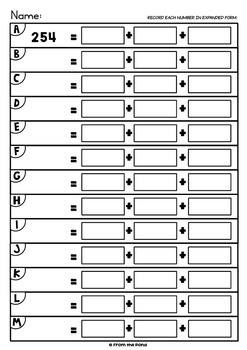

Students love learning new ways to memorize tricky concepts making this activity perfect to add to your lesson plans.Working on expanded form in math? Here are cool math ideas to practice the Common Core expanded form.
Expanded form how to#
This fun worksheet needs to be cut and glued together by students and serves as a reminder of how to convert scientific form to standard form. Scientific Notation to Standard Form Activity They can then fill in examples of standard forms and expanded forms. Simply, have your students follow the instructions to fold and cut where it states. When completed, this quadratic foldable will fit perfectly in student workbooks. They need to then pick the correct apple and basket card to make their number. Next, they spin the one’s spinner and write their number in the box. First, learners spin the tens spinner and choose their tens card. This sweet apple tree and matching cards can be laminated so that they can be reused. This can be used as a math station game or just as a fun review activity. The aim is to become the first player to not have any cards by answering the questions on expanding form and standard form. This is a great hands-on math activity for kids. When they write this in dry-erase marker, they can be wiped clean and reused by other students. These cute printable strips can be laminated and used by kids to write the number at the start in expanded form. They must then fill in the expanded form in dry-erase marker on each of the train carriages. Once laminated, hand the printable out to students to read the number on the train.

This activity is perfect for little ones who are just developing an understanding of expanded form. Students must write the answers in the correct spot on their answer sheets. It can be printed in black and white or in color. These fantastic task cards will be a great test of your student’s math skills! Each bundle comes with 32 task cards, a recording, and an answer sheet. Cut out and then stick as shown in the photo. Outline the monster’s hands, head, eyes, and smile. You’ll require pink, yellow, and black card stock. Simply glue the completed worksheet to the monster. This super fun craft can be differentiated for 2, 3, and 4-digit numbers. Students can make a number 0-99 by turning the cups to line up the numbers. On the second cup they mark out the tens, and, on the third, they can mark the hundreds.

On the first cup, students must mark out their ones. This is a great way to challenge students who are just starting to learn about expanding form.įor this activity, you will need a sharpie and at least 3 foam cups. These wonderful math worksheets teach children that expanded numbers are separated by place value. This is a great hands-on activity for little learners! Carefully following the instructions in the video, learners can make expanding paper snakes that depict their numbers in expanded form. The phrase “expand like a rubber band” will really stick in students’ heads! Stretch it out to show your students that you can expand the numbers as shown. Write the numbers from your expression on the board and hold up a rubber band. The winner is the student with the most cards at the end of the game. If they match, they get to keep them, if they don’t, they must put them back. Each student takes a turn turning over 2 cards. This can be played in pairs or small groups. Kids must draw the number in ten base blocks, write how many hundreds, tens, and ones there are, write the value of each number, and then write this in expanded form.

This example displays 3-digit numbers but can be adapted for 2, or 4-digit numbers too. They can also stack the cards first and pull them apart to see the expanded form. They then write these numerals onto their sheet in the correct spaces. In this fun number game, kids roll the dice included in the pack and choose the cards that match each of the 4 place values. Let’s take a look at some exciting expanded form activities. This knowledge is also important in a wide range of mathematical concepts including addition, subtraction, multiplication, and division. Learning the basics and understanding that numbers are composed of different place values allows students to simplify expressions and solve equations with ease. Although learning expanded form can be difficult for some students, it’s an important skill to learn.


 0 kommentar(er)
0 kommentar(er)
